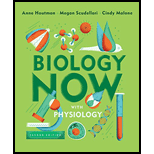
Concept explainers
During fertilization, two gametes are fused and produce a zygote, a single cell. The zygote contains a set of haploid (n) chromosomes from each gamete and that result in the formation of a diploid (2n) set of genetic material. Diploid cells consist of two sets of chromosomes (2n), one derived from the maternal origin and the other derived from the paternal origin. Human cells carry two copies of chromosomes (22 pairs of autosomes) and a single pair of sex chromosomes.
Answer to Problem 1TQ
Homologous chromosomes contain a pair of similar kind of chromosomes; each chromosome inherits from each parent (one from maternal and one from paternal). Therefore, option b is correct.
Explanation of Solution
Justify the reasons for the correct statement:
Each homologous pair of chromosomes present in the zygote contains a set of chromosomes, one derived from a mother and another from a father. The human genome contains twenty three (23) pairs of chromosomes. Homologous chromosomes carry a similar kind of genetic information in their corresponding loci. All pairs (22 pairs) of chromosomes carry the same genes or genetic information except X and Y chromosomes. The X and Y chromosomes are known as sex chromosomes and they involved in the determination of sexual characteristics in human beings. The remaining 22 pairs of homologous chromosomes are called autosomes.
The homologous pair of chromosomes found to be similar according to their size, physical character, pattern, and gene content. Homologous chromosomes carry two forms of a gene in the same locus are called alleles (same gene but different alleles).
Option (b) is given as, “a pair of chromosomes of the same kind”.
Hence, the option (b) is correct.
Justify the reasons for the incorrect statements:
Option (a) is given as, “the same thing as sister chromatids”.
Two identical DNA molecules after replication are known as sister chromatids. These chromatids are attached at the centromere until metaphase of the cell cycle. When sister chromatids are attached and it will be considered as a single chromosome. Hence, it is a wrong answer.
Option (c) is given as, “identical copies of the same chromosome”.
Two identical DNA copies of the same chromosome are known as sister chromatids. Hence, it is a wrong answer.
Option (d) is given as, “always haploid”.
A single set of chromosomes is known as a haploid. Hence, it is a wrong answer.
Hence, options (a), (c), and (d) are incorrect.
The homologous chromosomes are a pair of a same kind of chromosomes and they inherit from parents, one from the mother and another from the father.
Want to see more full solutions like this?
Chapter 6 Solutions
Biology Now with Physiology (Second Edition)
- Describe the principle of homeostasis.arrow_forwardExplain how the hormones of the glands listed below travel around the body to target organs and tissues : Pituitary gland Hypothalamus Thyroid Parathyroid Adrenal Pineal Pancreas(islets of langerhans) Gonads (testes and ovaries) Placentaarrow_forwardWhat are the functions of the hormones produced in the glands listed below: Pituitary gland Hypothalamus Thyroid Parathyroid Adrenal Pineal Pancreas(islets of langerhans) Gonads (testes and ovaries) Placentaarrow_forward
- Describe the hormones produced in the glands listed below: Pituitary gland Hypothalamus Thyroid Parathyroid Adrenal Pineal Pancreas(islets of langerhans) Gonads (testes and ovaries) Placentaarrow_forwardPlease help me calculate drug dosage from the following information: Patient weight: 35 pounds, so 15.9 kilograms (got this by dividing 35 pounds by 2.2 kilograms) Drug dose: 0.05mg/kg Drug concentration: 2mg/mLarrow_forwardA 25-year-old woman presents to the emergency department with a 2-day history of fever, chills, severe headache, and confusion. She recently returned from a trip to sub-Saharan Africa, where she did not take malaria prophylaxis. On examination, she is febrile (39.8°C/103.6°F) and hypotensive. Laboratory studies reveal hemoglobin of 8.0 g/dL, platelet count of 50,000/μL, and evidence of hemoglobinuria. A peripheral blood smear shows ring forms and banana-shaped gametocytes. Which of the following Plasmodium species is most likely responsible for her severe symptoms? A. Plasmodium vivax B. Plasmodium ovale C. Plasmodium malariae D. Plasmodium falciparumarrow_forward
- please fill in missing parts , thank youarrow_forwardplease draw in the answers, thank youarrow_forwarda. On this first grid, assume that the DNA and RNA templates are read left to right. DNA DNA mRNA codon tRNA anticodon polypeptide _strand strand C с A T G A U G C A TRP b. Now do this AGAIN assuming that the DNA and RNA templates are read right to left. DNA DNA strand strand C mRNA codon tRNA anticodon polypeptide 0 A T G A U G с A TRParrow_forward
 Human Anatomy & Physiology (11th Edition)BiologyISBN:9780134580999Author:Elaine N. Marieb, Katja N. HoehnPublisher:PEARSON
Human Anatomy & Physiology (11th Edition)BiologyISBN:9780134580999Author:Elaine N. Marieb, Katja N. HoehnPublisher:PEARSON Biology 2eBiologyISBN:9781947172517Author:Matthew Douglas, Jung Choi, Mary Ann ClarkPublisher:OpenStax
Biology 2eBiologyISBN:9781947172517Author:Matthew Douglas, Jung Choi, Mary Ann ClarkPublisher:OpenStax Anatomy & PhysiologyBiologyISBN:9781259398629Author:McKinley, Michael P., O'loughlin, Valerie Dean, Bidle, Theresa StouterPublisher:Mcgraw Hill Education,
Anatomy & PhysiologyBiologyISBN:9781259398629Author:McKinley, Michael P., O'loughlin, Valerie Dean, Bidle, Theresa StouterPublisher:Mcgraw Hill Education, Molecular Biology of the Cell (Sixth Edition)BiologyISBN:9780815344322Author:Bruce Alberts, Alexander D. Johnson, Julian Lewis, David Morgan, Martin Raff, Keith Roberts, Peter WalterPublisher:W. W. Norton & Company
Molecular Biology of the Cell (Sixth Edition)BiologyISBN:9780815344322Author:Bruce Alberts, Alexander D. Johnson, Julian Lewis, David Morgan, Martin Raff, Keith Roberts, Peter WalterPublisher:W. W. Norton & Company Laboratory Manual For Human Anatomy & PhysiologyBiologyISBN:9781260159363Author:Martin, Terry R., Prentice-craver, CynthiaPublisher:McGraw-Hill Publishing Co.
Laboratory Manual For Human Anatomy & PhysiologyBiologyISBN:9781260159363Author:Martin, Terry R., Prentice-craver, CynthiaPublisher:McGraw-Hill Publishing Co. Inquiry Into Life (16th Edition)BiologyISBN:9781260231700Author:Sylvia S. Mader, Michael WindelspechtPublisher:McGraw Hill Education
Inquiry Into Life (16th Edition)BiologyISBN:9781260231700Author:Sylvia S. Mader, Michael WindelspechtPublisher:McGraw Hill Education





